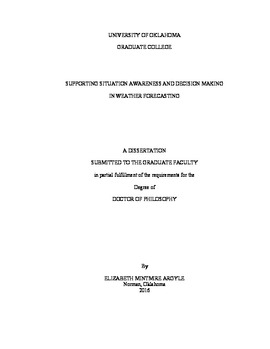| dc.description.abstract | Weather forecasting is full of uncertainty, and as in domains such as air traffic control or medical decision making, decision support systems can affect a forecaster’s ability to make accurate and timely judgments. Well-designed decision aids can help forecasters build situation awareness (SA), a construct regarded as a component of decision making. SA involves the ability to perceive elements within a system, comprehend their significance, and project their meaning into the future in order to make a decision. However, how SA is affected by uncertainty within a system has received little attention. This tension between managing uncertainty, situation assessment, and the impact that technology has on the two, is the focus of this dissertation.
To address this tension, this dissertation is centered on the evaluation of a set of coupled models that integrate rainfall observations and hydrologic simulations, coined “the FLASH system” (Flooded Locations and Simulated Hydrographs project). Prediction of flash flooding is unique from forecasting other weather-related threats due to its multi-disciplinary nature. In the United States, some weather forecasters have limited hydrologic forecasting experience. Unlike FLASH, current flash flood forecasting tools are based upon rainfall rates, and with the recent expansion into coupled rainfall and hydrologic models, forecasters have to learn quickly how to incorporate these new data sources into their work. New models may help forecasters to increase their prediction skill, but no matter how far the technology advances, forecasters must be able to accept and integrate the new tools into their work in order to gain any benefit. A focus on human factors principles in the design stage can help to ensure that by the time the product is transitioned into operational use, the decision support system addresses users’ needs while minimizing task time, workload, and attention constraints.
This dissertation discusses three qualitative and quantitative studies designed to explore the relationship between flash flood forecasting, decision aid design, and SA. The first study assessed the effects of visual data aggregation methods on perception and comprehension of a flash flood threat. Next, a mixed methods approach described how forecasters acquire SA and mitigate situational uncertainty during real-time forecasting operations. Lastly, the third study used eye tracking assessment to identify the effects of an automated forecasting decision support tool on SA and information scanning behavior. Findings revealed that uncertainty management in forecasting involves individual, team, and organizational processes. We make several recommendations for future decision support systems to promote SA and performance in the weather forecasting domain. | en_US |
